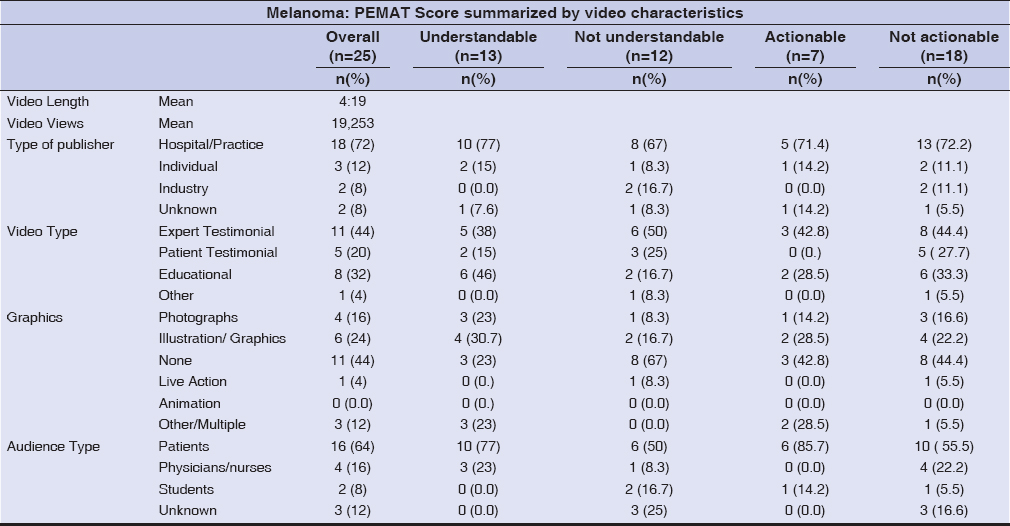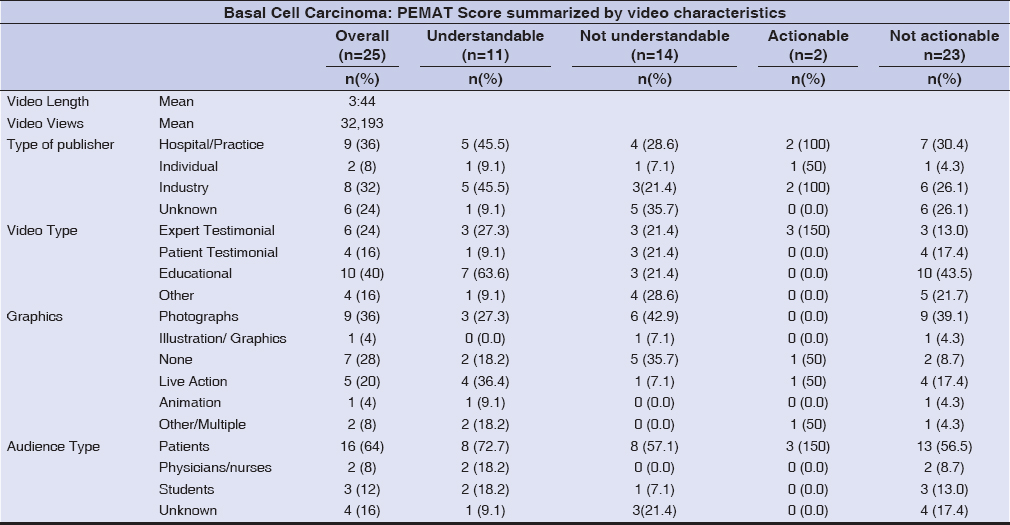Skin cancer and “Dr. YouTube.” Using PEMAT Scoring to Determine Understandability and Actionability of Audiovisual Patient Education Material
Summa Health System Department of Pathology and Laboratory Medicine Akron, Ohio, USA
Corresponding author: Ania Henning, M.D,
Submission: 19.02.2020; Acceptance: 17.04.2020
DOI: 10.7241/ourd.20203.20
Cite this article: Henning A. Skin cancer and “Dr. YouTube.” Using PEMAT Scoring to Determine Understandability and Actionability of Audiovisual Patient Education Material. Our Dermatol Online. 2020;11(3):309-311.
Citation tools:
Copyright information
© Our Dermatology Online 2020. No commercial re-use. See rights and permissions. Published by Our Dermatology Online.
Sir,
In an era of widespread social media access, patients may attempt self-diagnosis or self-treatment based on information found online. YouTube is a popular social media source of information for many patients, including information on skin cancers. Much of the YouTube information patients receive on skin cancer or skin disease is provided by consumer videos, rather than medical professionals [1]. Studies examining melanoma screening tools have shown videos submitted by medical or government professionals were more likely to have accurate content, better educational quality and avoid jargon [2,3]. Other studies have shown that many consumer YouTube videos on various health conditions are of poor quality in terms of information delivery, video layout and the use of explanatory pictures or other visual aids [3–5]. However, there seems to be a lack of studies, determining if videos made by medical professionals were made in such a way in which patients could process and use, regardless of educational background.
We sought to use the Patient Education Materials Assessment Tool (PEMAT) scoring system to assess the quality of medical educational YouTube videos specifically relating to melanoma and basal cell carcinoma (BCC). A YouTube search was performed using the descriptive terms “melanoma, medicine” and “BCC medicine.” The keyword “medicine” was added as an attempt to get a better quality of videos from reliable reputable sources. Studies regarding user behavior on the internet have indicated that the majority of the users will click on the results within the first few pages, thus each search was limited to the first 35 results [4]. Videos were sorted by relevance. Videos that were less than 1 minute or greater than 15 minutes in length, not from the United States, or not in English, were excluded. One examiner independently examined videos using PEMAT scoring for audiovisual materials [5]. The PEMAT deems patient education materials “understandable” when viewers of various backgrounds and literacy can process key messages. It deems videos “actionable” when viewers can clearly understand what they can do with the material presented in the videos [4,5]. The PEMAT uses 13 questions which pertain to content, word choice and style, organization, layout and design, and the use of visual aids. The “actionability” part of the scoring system consists of four criteria: whether the video addresses the viewer directly, the action the viewer can take and how they can take the action, and whether a concrete tool is provided for how the viewer can take the action [5]. A final score is then calculated using the PEMAT. A score below 70% classifies the video as poorly understandable or not actionable.
Video characteristics were noted and summarized by understandability and actionability. A total of 50 videos were viewed and PEMAT was calculated for each. The majority of the videos were targeted toward patients and published by a hospital or practice (Tables 1 and 2).
The intent of this preliminary study was to examine videos made by medical professionals and determine if the videos adequately explained key concepts regarding BCC and melanoma to the viewer/patient. Although social media has increased communication of health information, there is a general lack of quality control in terms of how information is relayed and what the patient is expected to do once informed. Most videos were not “actionable” even if the video came from a credible medical source, such as a hospital or clinic. Many videos lacked visual aids or cues that might aid in understanding. Medical professionals should consider using previously developed educational or informational tools in order to develop better quality educational videos for patients.
Consent
The examination of the patient was conducted according to the Declaration of Helsinki principles.
The authors certify that they have obtained all appropriate patient consent forms. In the form the patient(s) has/have given his/her/their consent for his/her/their images and other clinical information to be reported in the journal. The patients understand that their names and initials will not be published and due efforts will be made to conceal their identity, but anonymity cannot be guaranteed.
REFERENCES
1. Basch CH, Basch CE, Hillyer GC, Reeves R. YouTube videos related to skin cancer:a missed opportunity for cancer prevention and control. JMIR Cancer. 2015;1:e1.
2. Babamiri K, Nassab RS. The availability and content analysis of melanoma information on youtube. Plast Reconstr Surg. 2010;126:51e-2e.
3. Smeeton B, Wormald J, Plonczak A, Butler D, Hamilton S. A critical review of melanoma self-screening tools on YouTube –A missed opportunity?Int J Surg. 2018;55:e11-2.
4. Salama A, Panoch J, Bandali E, Carroll A, Wiehe S, Downs S, et al. Consulting “Dr. YouTube“:an objective evaluation of hypospadias videos on a popular video-sharing website. J Ped Urol. 2019;pii:S1477-5131(19)30411-5.
5. PEMAT Tool for Audiovisual Materials (PEMAT-A/V). Content last reviewed October 2013. Agency for Healthcare Research and Quality, Rockville, MD. https://www.ahrq.gov/ncepcr/tools/self-mgmt/pemat-av.html
Notes
Source of Support: Nil,
Conflict of Interest: None declared.
Request permissions
If you wish to reuse any or all of this article please use the e-mail (brzezoo77@yahoo.com) to contact with publisher.
| Related Articles | Search Authors in |
|
 http://orcid.org/0000-0002-1980-8515 http://orcid.org/0000-0002-1980-8515 |






Comments are closed.